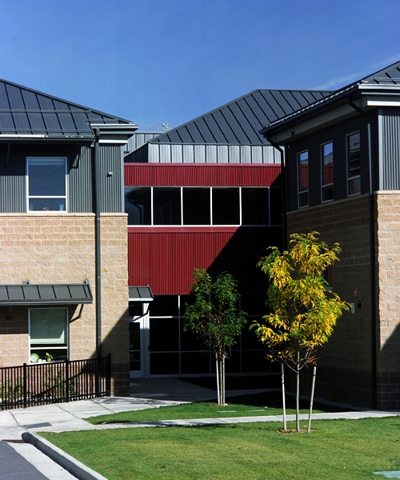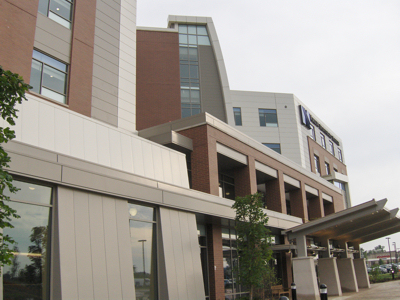Metal Wall Panels: An Industry Perspective – Part III
By Marge O'Connor, DesignandBuildwithMetal.com
Editor's Note: What's Ahead For Metal Wall Panels is the final installment of a three-part article based on extensive interviews with industry executives representing the makers of single-element metal wall panel systems, insulated metal wall panel systems and metal composite material wall panel systems. Part I, titled Metal Wall Panels – Going From Simple To Spectacular, can be read by clicking here. Part II, titled Targeting Decision Makers, can be read by clicking here.
What's Ahead For Metal Wall Panels
In general, the market challenges for metal wall panels are similar to what they have always been – stay a step ahead of the competition, educate buyers and code officials, and support industry research and product testing. But different needs and
opportunities lie ahead for specific wall panel segments, say our experts.

|
The exterior of the Regional Learning Alliance in Cranberry Township, PA is clad primarily with metal panels from CENTRIA.
The design also includes metal sunshades and other architectural elements. Click image to enlarge. | |
“Our industry’s ongoing challenge is staying competitive with other construction products as the cost of all building materials increases. For architects, metal offers what they really want – a high performing product that fits into
their design. For installers, metal is easy to use. And for building owners, the driving force is the enhanced building performance and energy efficiency of metal systems. As more people use the Internet to do their product research, metal will be
specified in building design and incorporated into the building envelope in many different ways,” says Ken Buchinger, vice president of business development and research and development for MBCI, Houston.
 |  |  |  |  |  |
| | Brandon Wyatt | | Doug Pickens | | Jim Bush |
Doug Pickens, vice president of marketing for Metl-Span LLC, Lewisville, TX says that the future is particularly bright for IMPs. “We stand to grow at an even faster rate than that of the last few years, where we had close to 20 percent growth per
year before the recession hit. We may see even faster growth rates when the economy comes back, and for a number of years running. But increased government regulation is the biggest challenge for IMPs going forward, particularly in regard to chemical
components. Right now chemical companies are working on the next generation blowing agent, which is not a VOC, has virtually zero global warming potential and continues to provide high R values.”

|
The Daybreak Elementary School and Community Center in Salt Lake Valley, UT uses metal wall panels with split faced concrete masonry to make the two-story, 117,000 square foot building more interesting and visually lighter. Many of the
exterior walls were constructed of heavy gauge cold-formed metal framing with metal panels from MBCI on
the exterior, which helped the building easily meet energy code requirements and attain a silver rating in the USGBC’s LEED certification program. Click image to enlarge. | |
Brandon Wyatt, Marketing Manager, 3A Composites USA (formerly Alcan Composites USA, Inc.), Charlotte, NC, notes that there’s also a great future for MCM panels in saving energy because the finishes have coatings that help create a cooler
building. “The evolution of the product will be a driving force for the future of the market – especially in regard to solar reflectivity and energy savings. You see it in MCM on roofs now, but wall panels will become a stronger force
in the future.”
Jim Bush, vice president of sales for ATAS International, Allentown, PA also points to sustainability and code requirements as key factors in future opportunities. “We need to stay on top of these, especially in regard to how all of the building
materials and components integrate with each other and how, when assembled together, they comply with codes. We need to raise awareness of the science behind wall panel assemblies, such as rainscreens, and create an understanding of the overall building
design and how metal wall panels play a role in keeping moisture out and energy efficiency in. When you look at some of the work now being done by ORNL [Oak Ridge National Laboratory] on building envelope research, you see that members of our industry
continue to step up to be part of this association-led research that no single manufacturer could possibly do alone.”
 | 
|  |  |  |  |
| | Julie Pawuk | | Ken Buchinger | | Rick Brow |
For several reasons, renovation and retrofit are prevalent trends for metal wall panels.
Funding to make buildings more energy efficient is more readily available and developers are realizing how retrofit can easily bring an existing building up to code while dramatically improving its appearance.
Bush, who chairs the Metal Construction Association’s Retrofit Task Force, emphasizes that metal is very competitive in retrofit because compared to other methods and materials it is more reliable, installs faster and is less expensive. “Metal
wall panels make it easier to add insulation materials to help bring existing buildings into compliance with new energy codes. An existing industrial building can be brought up to standards for mixed use and office space, particularly in areas that
are being renovated or gentrified,” he says.

|
Norton Brownsboro Hospital in northeastern Jefferson County, KY, offers a stunning example of how a blend of metal panels with other construction materials adds texture to a building's appearance. The insulated metal panels from Metl-Span, in bronze and oyster colors, also enhance the facility's energy
efficiency. The five-story, 298,000 sq. ft. hospital is the first new full-service hospital to open in the Louisville area in more than 20 years. Click image to enlarge. | |
“We are seeing more progressive developers acquiring properties that are in financial trouble and renovating them to bring them up to newer standards and codes. They are turning old commercial properties into new retail or mixed use with residential.
As long as the financial situation is good retrofit will remain prominent because it helps developers make better use of existing property,” Bush adds.
The future for metal in retrofit is very bright. From a marketing standpoint, however, when multiple decision makers are involved, reaching the right ones can be a more fragmented, challenging process.

|
At the Seven Clans Red Lake Casino in Red Lake Minnesota, Alucobond Spectra
wall panels were blended with other façade materials to create a unique and glowing look that also shows the capabilities of MCM to be engineered into creative forms such as the waves on this structure. Click image to enlarge. | |
It also opens up business opportunities. “With renovation and retrofit the architects still make decisions because they are pulled into the design. But we usually need to reach all of the players - architects, owners, contractors and developers.
Many times contractors are brought in first on retrofits, which opens up a whole new avenue for them to be consultants on these projects. As they work more on the design of retrofit, they have more opportunity to talk with building owners about using
it. This also lets them initiate the discussion about using metal wall cladding on the project,” notes Bush.
Along with retrofit, the green building movement is a prime area for metal wall panels, which also are part of “cool” technology. “We’ve heard a lot about cool roofs, but there also are wall systems, such as our Inspire Wall, that
add energy savings. In these systems, metal panels are used to collect solar energy for preheating ventilation air providing renewable energy. In this case metal panel systems can provide a payback within 3 to 5 years of installation. So, the
metal wall panel actually pays the building owner back,” adds Bush.

|
Perforated wall panels from ATAS International Inc. form
a unique architectural element while offering protection at North Carolina Central University's Biomanufacturing Research Institute and Technology Enterprise (BRITE) in Durham. | |
But our industry needs to keep metal visible in green building. “Metal is at the forefront of the whole green building movement, and many of us are doing a lot to keep metal there. But more needs to be done in some areas. LCA (Life Cycle Assessment),
for example, is more of a challenge for metal products. But that’s where the whole design and build industry is going, so we’ll need to work heavily on that,” says Rick Brow, director of marketing for CENTRIA, Moon Township, PA.
He also points to how our industry needs to play its strong card. “Our industry has always been innovative, but our biggest challenge is gaining acceptance for the innovation. When price becomes a motivator, as it tends to be in this kind of
economy, you have to convince the decision makers that metal is a better value than what’s out there,” Brow says.
No matter the challenges and the opportunities the best thing the metal construction market has is the cooperative effort among its many facets to keep metal the best of all construction materials. And the individual manufacturers are maintaining that
competitive edge in the way they create products, carry out their marketing programs and continue to keep research and education top priorities.
For hotlinks to the websites of the companies mentioned in this article, as well as dozens of other leading manufacturers of metal wall panel systems, please visit the Metal Wall Panels section of our Manufacturers & Suppliers Directory
here. By using the directory's category search feature you can see makers broken out according to 13 different metal wall segments.